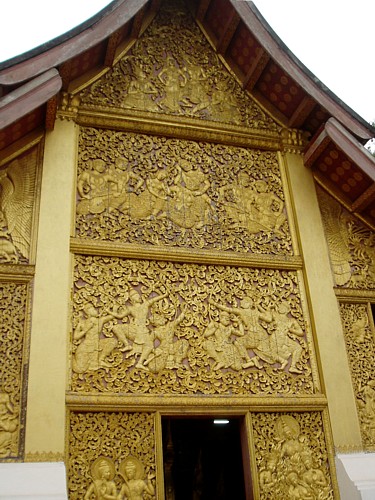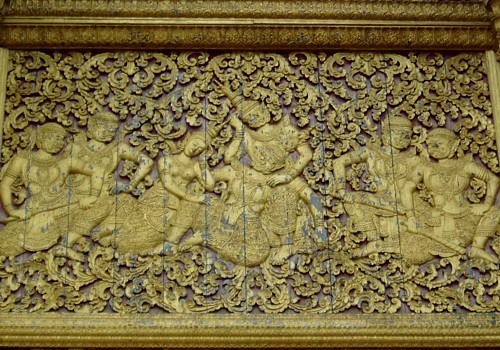
Designed by Manivong Khattiyarat (also spelt as Khattignarath) together with Phia Sing (1898-1967), Phia Thit Tanh (1909-2000) & Thit Bounthan, construction started in 1963 & was finished only in 1975. Ajan Manivong was the manager of the Royal Ballet troupe of Luang Prabang before the 1975 revolution, & is now the deputy director. He was also involved in the design of Hor Prabang. The creative process for the Wat Xieng Thong chariot hall as related by Ajan Manivong (taken from this source):
...Ajan Manivong started to design the entire narrative program of the Phra Lam Phra Lak, the Laotian version of the Indian-derived epic poem, Ramayana. Ajan Manivong mentioned that a traditional Laotian artist-designer often does not draw on a sketchbook; he instead sketches each episode from the story directly onto the wooden panels with a piece of chalk. Subsequently, members of the artistic team, for instance, Pia Sing (Ajan Manivong’s teacher), and Pia Tanh, the master woodcarver and his assistants, examined the sketches and gave their approval before Ajan Manivong fixed the drawing with a felt tip pen. Pia Tanh and his assistants carried out the carvings
The gilded carvings depicting scenes from the Phra Lak Phra Ram (ພຣະລັກພຣະຣາມ aka. Lao version of the Ramakien or Ramayana) that cover the exterior:

The death of the demon king of Lanka, Totsakan (aka. Ravana, middle figure sitting down), after his defeat by Pha Ram towards the end of the story:

He is mourned by his wife Mandodari (aka. Nang Mando, third from left) & his younger brother Vibhishana (aka. Pipek, holding him).
Not sure if this panel is the final battle scene with the good guys (including Hanuman) on the left & demons on the right:

Two birds feature in the triangular panels to the left & right of the above carvings:

The eagle king Sadayu (สดายุ aka. Jatayu) is the bird on the right, attacking the 20-armed demon king Totsakan who had kidnapped Nang Sida (aka. Sita). Sadayu was eventually defeated when Totsakan snatched Nang Sida's diamond ring & threw it at him. Mortally wounded, the bird managed to pass the ring to Phra Ram & inform him of Nang Sida's capture before dying. In another version of the story, the bird survives after Phra Ram healed its wings. Click here to see someone else's better photo of the full panel.
The bird on the left is Sampati, the elder brother of Sadayu, in the scene 'Hanuman rescues Sampati'. During the search for the missing Nang Sida, Hanuman & his army of monkeys found the featherless Sampati shivering in a mountain cave. Sampati had lost his feathers while protecting Sadayu from being burnt by the Sun God, after Sadayu had mistaken the sun for a golden fruit & tried to eat it. Sampati was cursed to remain featherless in this cave until the day Phra Ram's soldiers passed through. Hanuman & his monkey army were thus able to free Sampati & restore his plumage. In return, a grateful Sampati showed them the way to the Totsakan's kingdom of Lanka, where Nang Sida was being held.


No comments:
Post a Comment